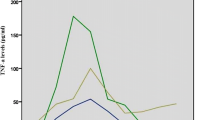Abstract
To determine the role of bacterial and host factors in the pathogenesis of shigellemia, blood and fecalShigella isolates were compared for serum resistance and siderophore production, and shigellemic patients were examined for decreased serum bactericidal activity or increased serum transferrin saturation compared to control patients with non-bacteremic shigellosis. The majority of both blood (36/38) and fecal (36/48)Shigella isolates were sensitive to normal serum (> 2 log kill/60 min).Shigella dysenteriae type 1 strains were the most sensitive, andShigella sonnei strains were the most resistant. Siderophore production was species- and serotype-dependent.Shigella dysenteriae type 1 produced only enterochelin; mostShigella flexneri expressed only aerobactin, andShigella sonnei secreted both types of siderophores. No difference in siderophores was noted between blood and fecal strains within a given serotype. In contrast, shigellemic patients exhibited a 43-fold decrease in serum bactericidal activity and a two-fold increase in transferrin saturation compared to well-nourished control patients. These results indicate that the pathogenesis ofShigella septicemia is not related to serum resistance or siderophore production but may involve serum abnormalities associated with malnutrition.
Similar content being viewed by others
References
Struelens MJ, Patte D, Kabir L, Salam A, Nath S K, Butler T. Shigella septicemia: prevalence, presentation, risk-factor and outcome. Journal of Infectious Diseases 1985, 152: 784–790.
Hale TL, Formal SB Pathogenesis ofShigella infections. Pathology and Immunopathology Research 1987, 6: 117–127.
Vosti KL, Randall E Sensitivity of serologically classified strains ofEscherichia coli of human origin to the serum bactericidal system. American Journal of the Medical Sciences 1970, 259: 114–119.
Williams PH Novel iron uptake system specified by ColV plasmids: an important component in the virulence of invasive strains ofEscherichia coli. Infection and Immunity 1979, 26: 925–932.
Reed WP, Albright EL Serum factors responsible for killing ofShigella. Immunology 1974, 26: 205–215.
Schade AL, Caroline L An iron-binding component in human blood plasma. Science 1946, 104: 340–341.
Carbonetti NH, Boonchai S, Parry SH, Vaisanen-Rhen V, Korhonen TK, Williams PH Aerobactinmediated iron uptake byEscherichia coli isolates from human extraintestinal infections. Infection and Immunity 1986, 51: 966–968.
Carbonetti NH, Williams PH A cluster of five genes specifying the aerobactin iron uptake systems of plasmid ColV-K30. Infection and Immunity 1984, 46: 7–12.
Pickett CL, Hayes L, Earhart CF Molecular cloning of theEscherichia coli K-12 entACGBE genes. FEMS Microbiology Letters 1984, 24: 77–80.
Coderre PE, Earhart CF Characterization of a plasmid carrying theEscherichia coli K-12entD, fepA, fes andentF genes. FEMS Microbiology Letters 1984, 25: 111–116.
Ford S, Cooper RA, Williams PH Biochemical genetics of aerobactin biosynthesis inEscherichia coli. FEMS Microbiology Letters 1986, 36: 281–285.
Bindereif A, Neilands JB Cloning of the aerobactinmediated iron assimilation system of plasmid ColV. Journal of Bacteriology 1983, 153: 1111–1113.
Gross R, Engelbrecht F, Braun V Identification of the genes and their polypeptide products responsible for aerobactin synthesis by pColV plasmids. Molecular and General Genetics 1985, 201: 204–212.
Grunstein M, Hogness DS Colony hybridization, a method for the isolation of cloned DNAs that contain a specific gene. Proceedings of the National Academy of Sciences of the USA 1975, 72: 3961–3965.
Feinberg AP, Vogelstein B A technique for radiolabelling DNA restriction endonuclease fragments to high specific activity. Addendum Analytical Biochemistry 1984, 137: 266–267.
Roantree RJ, Rantz LA A study of the relationship of the normal bactericidal activity of human serum to bacterial infection. Journal of Clinical Investigation 1960, 39: 72–81.
Blaser MJ, Smith PF, Kohler PE Susceptibility ofCampylobacter isolates to the bactericidal activity of human serum. Journal of Infectious Diseases 1985, 151: 227–235.
Taylor PW Bactericidal and bacteriolytic activity of serum against gram-negative bacteria. Microbiological Reviews 1983, 47: 46–83.
McElree H, Pitcher J, Arnwine, J Transiently acquired serum resistance by cell-grownEscherichia coli. Journal of Infectious Diseases 1966, 116: 231–237.
Blaser MJ, Perez GP, Smith PE, Patton C, Tenover FC, Lastovica AJ, Wang W-LL ExtraintestinalCampylobacter jejuni andCampylobacter coli infections: host factors and strain characteristics. Journal of Infectious Diseases 1986, 153: 552–559.
Weinberg ED Iron and infection. Microbiological Reviews 1978, 42: 45–66.
Valvano MA, Crosa JH Aerobactin iron transport genes commonly encoded by certain ColV plasmids occur in the chromosome of a human invasive strain ofEscherichia coli K1. Infection and Immunity 1984, 46: 159–167.
Perry RD, San Clemente CL Siderophore synthesis inKlebsiella pneumoniae andShigella sonnei during iron deficiency. Journal of Bacteriology 1979, 140: 1129–1132.
Payne SM Synthesis and utilization of siderophores byShigella flexneri. Journal of Bacteriology 1980, 143: 1420–1424.
Payne SM, Niesel DW, Peixotto SS, Lawlor KM Expresion of hydroxamate and phenolate siderophores byShigella flexneri. Journal of Bacteriology 1983, 155: 949–955.
Lawlor KM, Payne SM Aerobactin genes inShigella spp. Journal of Bacteriology 1984, 160: 266–272.
Schmitt MP, Payne SM Genetics and regulation of enterobactin genes inShigella flexneri. Journal of Bacteriology 1988, 170: 5579–5587.
Payne SM Iron and virulence inShigella. Molecular Microbiology 1989, 3: 1301–1306.
Simmons DAR Structure ofShigella flexneri serotype 6-R (rough) lipopolysaccharide. Biochemical Society Transactions 1983, 11: 386–387.
Witkowska D, Adamus G, Mulczyk M, Romanowska E Outer membrane protein composition ofShigella flexneri. FEMS Microbiology Letters 1982, 13: 109–111.
Nassif W, Mazert MC, Mounier J, Sansonetti PJ Evaluation with an iuc: Tn10 mutant of the role of aerobactin production in the virulence ofShigella flexneri. Infection and Immunity 1987, 55: 1963–1969.
Bennish ML, Wojtyniak BJ, Struelens MJ Death in shigellosis: incidence and risk factors in hospitalized patients. Journal of Infectious Diseases 1990, 161: 500–506.
Lawlor KM, Daskaleros PA, Robinson RE, Payne SM Virulence of iron transport mutants ofShigella flexneri. and utilization of host iron compounds. Infection and Immunity 1987, 55: 594–599.
Author information
Authors and Affiliations
Rights and permissions
About this article
Cite this article
Struelens, M.J., Mondal, G., Roberts, M. et al. Role of bacterial and host factors in the pathogenesis ofShigella septicemia. Eur. J. Clin. Microbiol. Infect. Dis. 9, 337–344 (1990). https://doi.org/10.1007/BF01973740
Issue Date:
DOI: https://doi.org/10.1007/BF01973740




